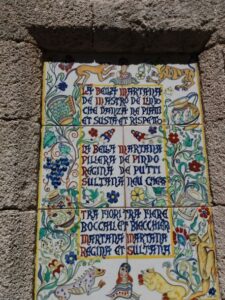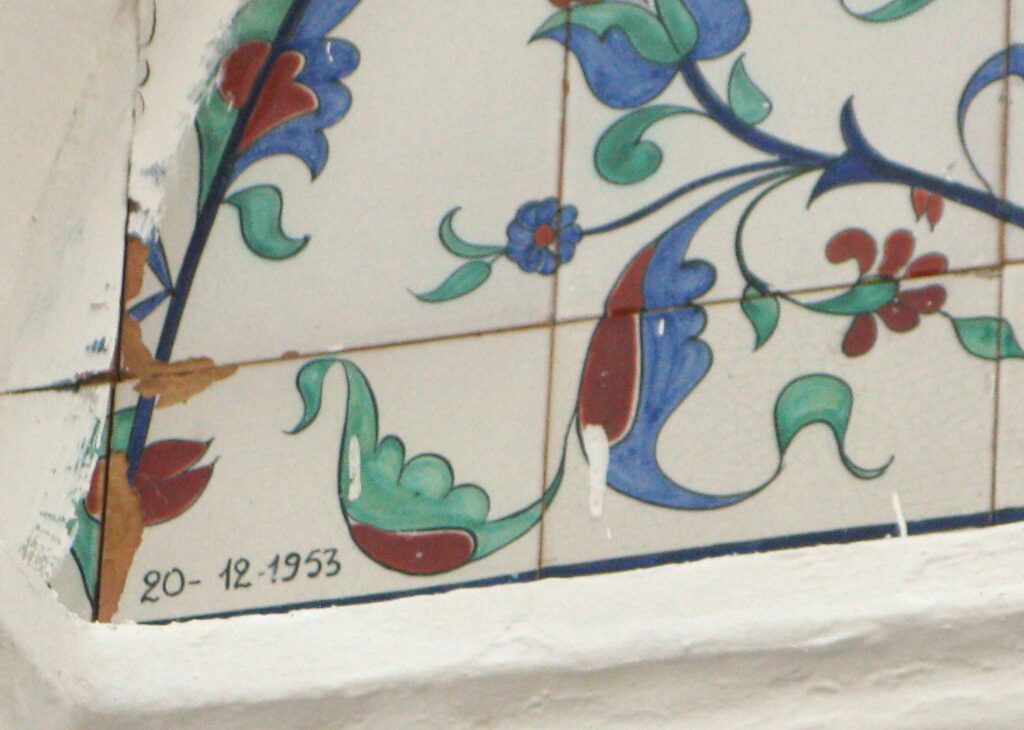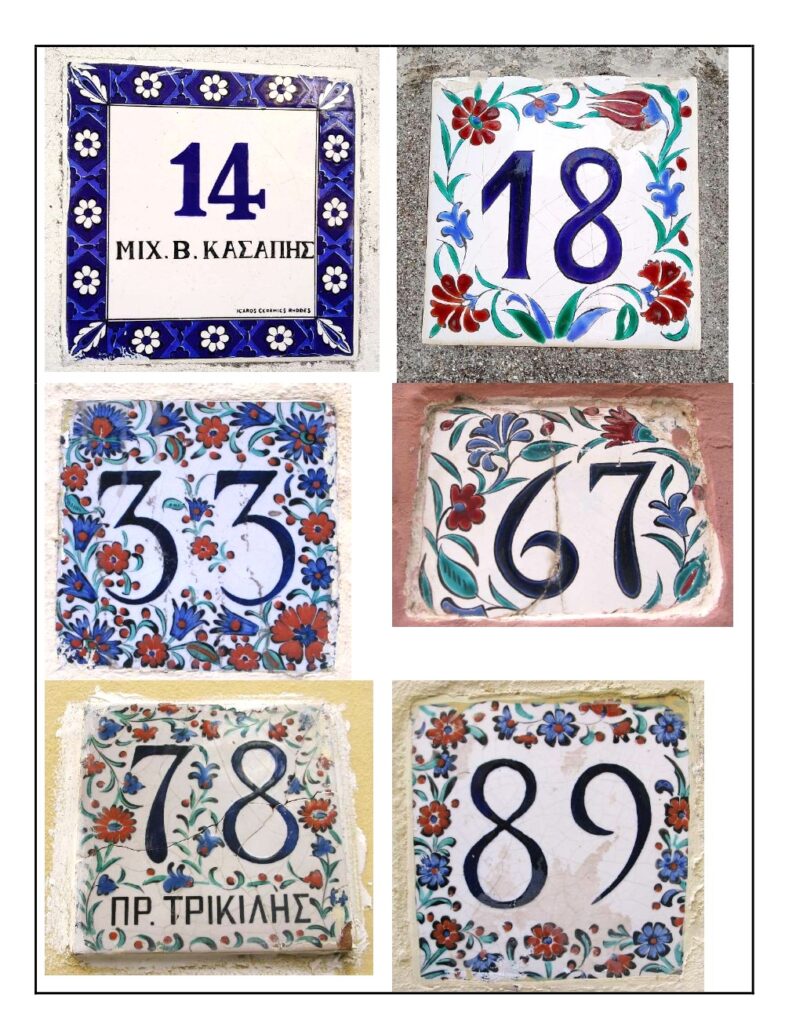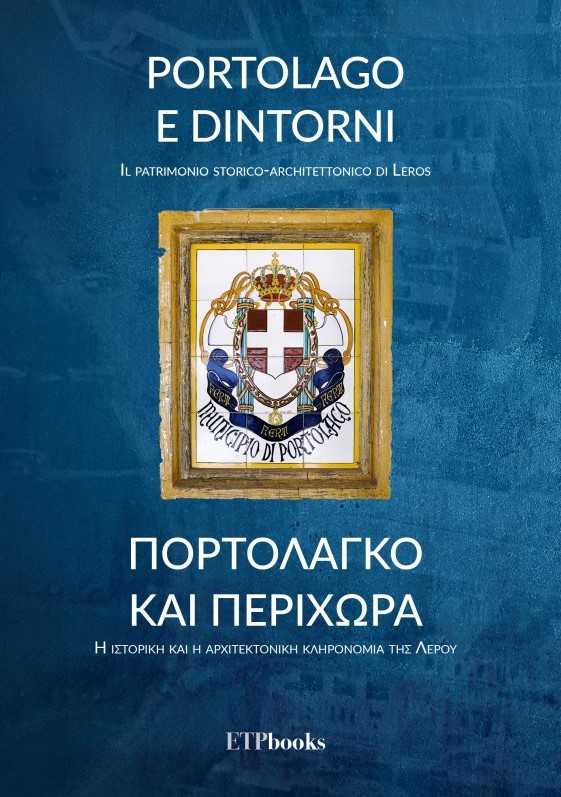
The Bents visited Rhodes briefly (then Turkish, now in the Dodecanese) in early 1885 on their way to explore nearby Karpathos. Theodore wrote up his stay on the island in an article tagged as ‘Rhodian Society’ (Macmillan’s Magazine, Vol. 52 (1885 May/Oct), 297-303). As tradition ruled, the Turks would not allow the ‘Franks’ to reside within the great (if battered) walls of Rhodes’ Old Town, and the Bents based themselves in a modest pension not far from where the Grande Albergo delle Rose (Rhodes Casino) is today. (They make make contact with the influential Biliotti family, a name that will appear again below.) Lawrence Durrell describes the area in his Reflections on a Marine Venus (London, 1953) – the still unmatched English book on the island. His paean makes several references to Rhodian ceramics and potters – a tradition reaching back millennia and continuing vibrantly in Durrell’s time, notably in the studios and workshops of the Italian I.C.A.R.O. company (the Italians, of course, having ousted the Turks, after a stand at Psinthos, in 1912).
Theodore and Mabel also admired the iconic (and highly collectible) pottery, especially the wall-plates, and returned to London with some: “The walls are surrounded by plates and jugs for household use. Once upon a time these utensils consisted of Lindos ware, but now these have all found their way to the museums and drawing-rooms of Europe. The greatest feature of a peasant’s house is the decoration of the wall opposite the door as you enter…” (ibid. p.302).

One of the great potters in Durrell’s day was the enigmatic I.C.A.R.O director, Egon Huber; Marine Venus is glazed with undisguised admiration for him. His story is little known, and, while awaiting the Solomonesque ruling of some Wikipedia judge, we can shed a little light on him: he well merits it.
Our subject

Egon Huber (1905-1960), was an Austrian designer, ceramicist, sculptor, installation artist, and philhellene. He is best known for his association with the Industria Ceramiche Artistiche Rodio Orientali (I.C.A.R.O.) company, on the island of Rhodes, in the 1930s and 1940s.
“Egon Huber, an Austrian potter who has lived here for some fifteen years and has been responsible for much of the lovely Icarus pottery turned out during the Italian dispensation.” (writes Lawrence Durrell)
Early life

Huber was born in Bregenz, Austria, in 1905, spending his early years in Salzburg. As a boy he was multi-talented, interested in all the arts, photography, and music (he played the guitar and violin). He expressed a desire early on to become a painter and sculptor and secured a place after the First World War at the University of Vienna, where he added ceramic arts to his studies. After university Huber lectured at the Academy of Fine Arts in Vienna. note 1
The Eastern Mediterranean
 By his late twenties, seeking a more creative and artistically fulfilling life, he embarked on a solo journey in a dinghy from Vienna (or Venice according to Lawrence Durrell, who comes to know Huber well in the 1940s), via the Danube, the Black Sea, and the Turkish littoral, to Egypt. This odyssey was cut short in 1931, however, when Huber met with a violent storm off the island of Symi that blew him across the strait to the island of Rhodes, in the Dodecanese, at that time in the hands of the Italians. note 1 note 2 He immediately formed an attachment to the island and it became his home for the next twenty-five years – an equanimitable personality enabling him to cope with Greeks, Italians, Germans, and British alike during his long residence.
By his late twenties, seeking a more creative and artistically fulfilling life, he embarked on a solo journey in a dinghy from Vienna (or Venice according to Lawrence Durrell, who comes to know Huber well in the 1940s), via the Danube, the Black Sea, and the Turkish littoral, to Egypt. This odyssey was cut short in 1931, however, when Huber met with a violent storm off the island of Symi that blew him across the strait to the island of Rhodes, in the Dodecanese, at that time in the hands of the Italians. note 1 note 2 He immediately formed an attachment to the island and it became his home for the next twenty-five years – an equanimitable personality enabling him to cope with Greeks, Italians, Germans, and British alike during his long residence.
‘Industria Ceramiche Artistiche Rodio Orientali’ (I.C.A.R.O.)

In early 1928, an Italian pottery company ‘Industria Ceramiche Artistiche Rodio Orientali’ (I.C.A.R.O.) had been founded on Rhodes, as part of the administration’s plan to industrialise the Dodecanese islands, to produce and market a range of pottery for export generally and to sell to the growing number of European tourists. note 3 The business model was a sound one, based on regenerating the early designs, many of Iznik/Syrian/Levantine origin, that had been made so popular by the ateliers of Lindos and Archangelos, on Rhodes’ southern coast, since medieval times. Hearing of Huber’s background in ceramics, a meeting took place with I.C.A.R.O. director Alfred Biliotti, who offered the Austrian a position as ceramic designer. note 1 The creative team included two Italians, Luigi de Lerma and Dario Poppi, note 4 and, briefly, the German potter Günther Stüdemann. note 5 Huber’s imagination, creative, distinctive designs, line and use of colour made him a key figure in I.C.A.R.O.’s initial phase (1928 – c. 1942) and he was appointed its first artistic director. note 1 It seems clear that Huber was a gifted linguist – German, Greek, Italian, English….
Friendship with Lawrence Durrell

For a portrait of the artist, there are many references to Huber in Durrell’s ‘Reflections on a Marine Venus’ (1953). Durrell was stationed on Rhodes as Information Officer for two years when the Dodecanese were under British Administration (1945-1947). The English writer describes Huber as “a born solitary, tall, fair-haired… one of the aristocrats of the spirit — the poor artist who wishes for nothing but a chance to create.” note 2 The melancholy tone is appropriate, the war has effectively brought an abrupt end to the heady days of I.C.A.R.O.’s first, and best, period. Huber now spends his time beach-combing, note 2 and fishing. note 6 There was time, too, to make gifts for Durrell’s tiny home (a stone’s throw from the Casino, it still stands) – two white vases: “I remember so vividly the thump of the clay on the wheel, and the gradual emergence of their fine stems under the broad thumbs of Egon Huber”. note 7 There exists a classic black-and-white photograph of Huber at his wheel. note 8 note 9 The title of Durrell’s book on Rhodes even has an association with Huber, who was apparently present when the eponymous ‘Marine Venus’ was buried, in late 1942, to keep it out of the hands of the approaching Germans. note 10

Metamorphosis and IKAROS

The German occupation of the Dodecanese, and the duration of the Second World War, ushered in a second, much less productive phase for the ceramics firm, with Huber being obliged to focus less on I.C.A.R.O. and more on designing propaganda material. note 11 By this time, the artist was living in one of the medieval windmills that cluster around the windy northern point of Rhodes town. Durrell calls it “a little Martello tower much ruined by damp and neglect. How he avoided having to join the German Army is a miracle… He works in desultory fashion at the ruined workshop outside the town where in the past this world-famous pottery brought him tourists in their thousands and where shortage of clay has reduced him to poverty.” note 2


When the Italian colonists ceded Rhodes, and the Dodecanese, to Greece officially in 1947, the assets of I.C.A.R.O. were acquired by a Rhodian entrepreneur, who neatly rebadged the new Greek company as IKAROS, and it continued to produce decorative and popular ceramics until 1988. note 11 The metamorphosed pottery enterprise lasted exactly 60 years, and the output from the firm’s first phase is now widely collected worldwide, based much on the creative energy and imagination of Egon Huber. note 12
Marriage and later life

Huber, meanwhile, was tempted away from his old firm in 1947 to head up a rival company on Rhodes, in Rodini, on the main road to Lindos, and an offshoot of the large Athenian ceramics manufacturer – Kerameikos S.A. note 13 While arranging this in Athens, Huber, now in his forties, met a chemistry student, Elpida Bianchini, who was working as a colour specialist in the Kerameikos factory at Neo Phaliro. note 14 Elpida came to Rhodes as Huber’s wife and the couple had a daughter. Huber was to run “Kerameikos – To Rodini” from 1947 until the factory closed some eight years later. note 14

Huber now found himself out of work and with no option but to leave Rhodes, much changed since he had found himself washed ashore there in 1931. He and his family moved to Athens, where he was taken on as a painter in the main Kerameikos factory, near which he lived. note 14

These changes, and the fact that he had lost his own creative bearings, as well as having to provide for his family, eventually led to something of a crisis that saw Huber resigning and temporarily moving back to Vienna in 1956, to stay with his sister, while he searched for some artistic meaning in his life; he was 51. There he began to find inspiration in modernist sculpture and installation art, collaborating with an old friend, the sculptor Rudolf Hoflehner (1916-1995). note 15 (Hoflehner spent 6 months travelling in Greece in the mid 1950s, presumably spending time with the Hubers.) With a new sense of direction, Huber returned to Athens, and a break seemed to come in 1960 when he and Hoflehner were commissioned to represent Austria at the Venice Biennale that Autumn. Huber busied himself preparing a series of large pieces in stone and iron (a look at Hoflehner’s work might give a clue as to what Huber was designing), but he was not to complete them, he died that summer in Athens, aged just 55. note 14
Huber’s work and legacy

Rare examples of Huber’s early work are to be found today in the Benaki Museum, Athens and in private collections. He specialised in scenes composed of ceramic tiles, his influence being seen in his icon of the Virgin of Filerimos, decorative plaques for the port authorities of the region, and the amusing tile illustration of the doggerel ‘La bella Martana, De Mastro De Lindo’, preserved today in the small courtyard behind I.C.A.R.O.’s former showroom at the bottom of the Street of Knights in Rhodes’ Old Town. note 16 Numerous other decorative pieces are still to be seen.
Huber’s work featured in the exhibition “ICARO – ΙΚΑΡΟΣ The Factory of Rhodes 1928-1988” in 2017 in Athens note 17 and 2018 on Rhodes. note 18 note 19

In 1935 Huber also designed a highly decorative pictorial colour map/poster (69 x 49 cm) of Rhodes for the Italian State Tourist Department (ENIT), promoting his island and its legends, history and traditions. note 11 The composition is dominated, as might be expected, by Huber’s interpretation of the Colossus.
We would be delighted to hear from you if you have any further information on Egon Huber you would care to share.

The Pavilion of the Italian Aegean Islands (the ‘Rhodes Pavilion’) was designed in 1938 by the Roman architect Giovanni Battista Ceas for the Geographical section of the Mostra d’Oltremare to celebrate the Italian occupation of the Dodecanese archipelago in May 1912. It contains a fine array of ceramic tiles of Iznik design (now much defaced) in a section referred to as the ‘Lindos House’. It is hard to think that Huber would not have made some contribution, or was unaware of the project.
A coda
In his great book on Rhodes, Durrell glazes a vase of his own, decorating it with the sense of his little house in the Turkish cemetery, the Villa Cleobolus: “The silence seems saturated with a thousand forgotten essences: contained and held, somehow, in the bright peasant carpet, the crude warm pottery of Rhodes on which Huber has traced so lovingly these dancing figures…” (Reflections on a Marine Venus, p.54). Huber has made Durrell and Eve a house-warming present. And a few years later Durrell remembers it in a poem: “Bring joy, as lustrous on this dish / The painted dancers motionless in play / Spin for eternity, describing for us all / The natural history of the human wish.” (‘In the Garden: Villa Cleobolus’, from Collected Poems, 1931-1974. London, 1980, p. 58). There is every chance Huber’s present to Durrell and Eve Cohen survives.
Notes
Return from Note 1
Return from Note 2
Return from Note 3
Return from Note 4
Return from Note 5
Return from Note 6
Return from Note 7
Return from Note 8
Return from Note 9
Return from Note 10
Return from Note 11
Return from Note 12
Return from Note 13
Return from Note 14
Return from Note 15
Return from Note 16
Return from Note 17
Return from Note 18
Return from Note 19
- Ioannidis, Yiannos (2017). ICARO – IKAROS The Pottery Factory of Rhodes, 1928-1988: 99-101 (in Greek). The Benaki Museum, Athens.
- Ioannidis, Yiannos (2019). I.C.A.R.O. – IKAROS: the pottery factory of Rhodes (1928-1988), in M. Panagiotaki, I. Tomazos and F. Papadimitrakopoulos (eds): Cutting-edge Technologies in Ancient Greece: Materials Science applied to Cutting-edge technologies in ancient Greece: materials science applied to trace ancient technologies in the Aegean world: proceedings of two conferences held in Rhodes, 12–14 January 2018 and 11–13 January 2019: 153–160. Oxbow Books, Oxford.
- Diakosabbas, Giōrgos (2019). I.C.A.R.O. (1927-1947) – Ikaros (1948-1987): 60 chronia kallitechnikēs angeioplastikēs rodioanatolikēs technēs (in Greek). Giōrgos Al. Diakosabbas, Rhodes.
- Durrell, Lawrence (1953). Reflections On A Marine Venus, a companion to the landscape of Rhodes. Faber and Faber, London.
- For Rudolf Hoflehner, see Wikipedia (in German).
- Rudolf Hoflehner, by Rudolf Hoflehner and Werner Hofmann, 1966, Thames & Hudson, London.

Gallery
Other ceramics most probably by ICARO, IKAROS, Kerameikos – To Rodini. It is hard not to look for, or see, the influence of Egon Huber in these fine examples of the potter’s art.
 ICARO were possibly commissioned to produce a series of wall plaques, for the port authorities on various islands of the Dodecanese. This one is from Karpathos – disfigured due to anti-colonial sentiment (photo: Alan King).
ICARO were possibly commissioned to produce a series of wall plaques, for the port authorities on various islands of the Dodecanese. This one is from Karpathos – disfigured due to anti-colonial sentiment (photo: Alan King).
Kalymnos has two beautiful ones, one set in a tile surround. The ‘E.A. IX’ (bottom right) signifies 1931 (9th year of the Fascist Era) and so the work may just have had some input by Huber, who arrival on the island that year (phot: The Bent Archive).
Leros has a complete one, as well as another produced for the Municipality (as shown on the cover of ‘Portolago’ published by ETP Books).
 The exquisite tile sequence above the entrance to Agias Anastasias (Church of St Anastasia) in the Marasia, outside the city walls of Rhodes. The inscription includes the word ‘Pharmacist’, indicating the Saint’s powers as a healer.
The exquisite tile sequence above the entrance to Agias Anastasias (Church of St Anastasia) in the Marasia, outside the city walls of Rhodes. The inscription includes the word ‘Pharmacist’, indicating the Saint’s powers as a healer.
 The date (bottom left) is 1953 and the factory remains untraced for the moment. Egon Huber was working at ‘Rodini’ at the time, and the free flowing lines of the foliage, almost playful, are redolent of his hand. Note the crass way the tops of the tiles have been painted over.
The date (bottom left) is 1953 and the factory remains untraced for the moment. Egon Huber was working at ‘Rodini’ at the time, and the free flowing lines of the foliage, almost playful, are redolent of his hand. Note the crass way the tops of the tiles have been painted over.




ICARO tiles (c. 1930) above an entrance to the Catholic Church of Our Lady of Victory (also known as ‘Sancta Maria’) in the central district of Neohori, Rhodes town. ‘Non tibi sit grave dicere Mater Ave’/ ‘To say one Hail Mary is no burden’. The elegant lettering extending from one tile to another; the emblematic Rhodian double hibiscus focusing the mind on the message.

Some antique house tiles in Rhodes town (5/02/2023), continuing the style and tradition of Icaro, and Egon Huber and his associates. The cruder numbering suggests later changes.
 A name tile, ‘Yusuf Soyal’, from a street in Rhodes town, Rhodes, Greece (photo: The Bent Archive).
A name tile, ‘Yusuf Soyal’, from a street in Rhodes town, Rhodes, Greece (photo: The Bent Archive).

Copies of some of the ICARO and Turkish (?) tiles on the façade of the significant 1930s’ property on the corner of 28 October and Griva, Rhodes town, Rhodes, Greece. The villa’s interior was also once extensively tiled, one hears. The originals are believed lost.
 Leave a comment or contact us about this article
Leave a comment or contact us about this article



